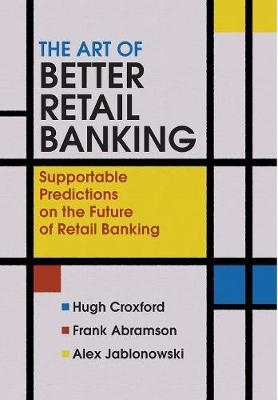
The Art of Better Retail Banking
John Wiley & Sons Inc (Verlag)
978-0-470-01320-5 (ISBN)
"This new book on retail banking is both readable and innovative. Its analysis is unusually accessible in its style, and the book's conclusions and predictions will be rightly thought provoking. The customer is gaining real power and this new book's insights on the importance of leadership, the need to unleash creativity and to make a bank's IT and people resource work together more effectively for customer satisfaction are important pointers to the shape of future competitive differentiation."
--Sir Mervyn Pedelty, Recently retired Chief Executive, The Co-operative Bank plc, smile, CIS and Co-operative Financial Services
"A stimulating read. A readable and lively book that is always informative, sometimes controversial and invariably challenging. The authors don't expect readers to agree with it all, but the readers will undoubtedly gain some fresh insights and perspectives on the multiple issues facing management in a rapidly changing industry."
--Chris Lendrum CBE, Recently retired Vice Chairman, Barclays Bank
"This book is clear enough for the layman and thorough enough for any banker to obtain an excellent sense of the options for successful strategies for their retail businesses. The challenges of technology introduction, cost of production and scope of service are driving banks into responses increasingly similar to other industry sectors. These forces have been apparent for some years but are so evident now they can no longer be ignored. This book provides an excellent guide to mapping that future."
--Joseph DeFeo, CEO, CLS Bank.
"This is a useful guide to retail banking that provides a thought-provoking view on the state of The Art (of Better Retail Banking). Clearly retail banking can get better, and must! To steal an analogy from the conclusion, there is a sea change going on - consumers are looking more and more for greater simplicity and value, and so many banks are still making such heavy weather of it. This book does a good job of charting the current developments."
-- Lindsay Sinclair, CEO, ING Direct UK.
"A whistle-stop tour of all aspects of retail banking. This is a very readable and insightful real world mix of theory, strategy, tactics and practice. They have even managed to make banking sound exciting. But mostly they have been able to cut through the complexity to remind us all that success in retail banking is not just about finance and efficiency - it is about customers and staff, who are all too often forgotten about."
--Craig Shannon, Executive Director - Marketing, Co-operative Financial Services.
"The authors live up to their promise of providing managers and students with a clear exposition of the retail banking sector and how banks can confront the challenging future they face. This book is a practical manual with lots of useful advice. I was looking for new insights in this book - and I found them!"
--Professor Adrian Payne, Professor of Services Marketing, Director, Centre for Services Management, Cranfield School of Management.
"A key determinant of any organisation's success will be an enhanced understanding of 'value' as defined by customers, employees, shareholders and other stakeholders. Value can mean different things to these different groups, and this book has set itself the objective of identifying the approaches that will improve the value proposition for all of these interested parties. It achieves this objective."
--Professor Steve Worthington, Faculty of Business and Economics, Monash University.
"An enjoyable and useful read. It provides a good perspective on the role of IT and how IT suppliers and professionals need to contribute to future developments in retail banking strategy and implementation. It helps provide guidance for the significant challenges ahead for both suppliers and the Banks."
--Nick Caplan, Managing Director, Global Financial Services, LogicaCMG.
About the authors Hugh Croxford After a career in banking, Hugh now assists banks and IT companies in interim capacities, much of which involves creative writing. Frank Abramson After a successful marketing career in FMCG, retailing and financial services at senior and Board levels, Dr Frank B Abramson co-founded The Relationship Consulting Group in 1992. Today he is CEO of RCG and also holds non-executive director posts with Intramezzo, Verdandi and M-I-G. Alex Jablonowski Formerly, Alex held a number of senior roles in banking, latterly as CEO of a London based merchant and private bank and before that Managing Director responsible for international corporate and institutional banking at Barclays. He now has a number of advisory and non executive roles including the Highways Agency, Veterans Agency and Companies House.
Preface xiii
Background and Acknowledgements xxiii
About the Authors xxv
Part I Setting The Scene 1
1 Introduction 3
1.1 Objective 3
1.2 Science and engineering 5
1.3 Science, art and engineering 6
1.4 A brief look back, and the culture of retail banking 8
1.5 The view from the bridge 10
1.6 We have to start from where we are 11
1.7 Are banks ‘unpopular’? 12
1.8 The path to popular popularity 13
1.9 And get this too . . . 14
1.10 Change is in the air – confidence, simplicity, speed 15
2 The Basic Model 17
2.1 Profit and return on equity 18
2.2 Capital requirements 19
2.3 Interest spread and interest margin 21
2.4 Non-interest income (fees and commissions) 24
2.5 Costs and the cost/income ratio 25
2.6 Loan losses 26
2.7 Taxation 26
2.8 Our loan of £1000 26
2.9 Performance measurements 28
2.10 The different businesses within banking 30
2.11 Assets, liabilities, treasury, capital markets 31
2.12 Caveat – definitions 32
2.13 To really understand it without it hurting 33
2.14 Some further points 33
3 Accounts, Services and Channels 37
3.1 Accounts 37
3.1.1 Current accounts 37
3.1.2 Savings accounts 38
3.1.3 Loan accounts 39
3.2 Payments 39
3.3 Services – fee-based and commissions 40
3.4 Delivery channels 42
3.4.1 Branches 43
3.4.2 ATMs 44
3.4.3 Digital 45
3.4.4 Postal banking 45
3.5 Bank cooperative channels 45
3.6 And some other points 46
3.6.1 Account variations 46
3.6.2 Bank cost allocation methodologies 48
3.6.3 And on product performances 49
4 Real Banks and Challenges 57
4.1 Some lists of banks – international banks 57
4.2 Globalisation 62
4.3 UK banks 63
4.3.1 HSBC 66
4.3.2 Royal Bank of Scotland 66
4.3.3 HBOS 67
4.3.4 Barclays Bank 67
4.3.5 Lloyds TSB 67
4.3.6 Abbey National 67
4.3.7 Standard Chartered 68
4.3.8 Alliance & Leicester 68
4.3.9 Northern Rock 68
4.3.10 Bradford & Bingley 68
4.3.11 Yorkshire Bank 68
4.3.12 The Co-operative Bank 69
4.3.13 Clydesdale Bank 69
4.3.14 Egg 69
4.3.15 Northern Bank 69
4.4 A little more detail on some UK banks 69
4.5 Building societies 73
4.6 The challenges for banks 74
4.7 Costs and the cost/income ratio 76
4.8 Risks 77
4.8.1 Credit risk 79
4.8.2 Treasury risks 80
4.8.3 Operational risk 81
4.8.4 Other risks 81
4.8.5 The risk about risks 82
4.9 Differentiators 83
4.10 Acquaintanceships 84
4.11 Trends 85
4.12 Competition 88
4.12.1 The Y2K experience 90
4.12.2 Competitive business models 90
4.12.3 Offset accounts 90
4.12.4 Super retailers 90
4.13 Pricing 92
4.14 Roundup 93
4.14.1 The realisations 94
4.15 Key observations 96
5 Systems and Information Technology (IT) 99
5.1 Legacy systems 100
5.2 Banks are dependent on data and information processing 102
5.3 Information technology will become a major differentiator 105
5.4 IT and the retail banking industry 107
5.4.1 There are additional pressures now 109
5.5 The IT industry is not without blame 111
5.6 Resolving the legacy systems problem 113
5.7 A new approach from the IT industry and from banks 115
5.8 Applications solution/software licensing 118
Part II The Propositions 119
6 The Real World 121
6.1 Basic findings on business strategy 121
6.2 Investment intensity – a big difference 130
6.2.1 Balance sheet differences 131
6.3 The people, processes and technology of capital investment 133
6.4 Product/service fitness-for-purpose 135
6.5 Brand, service, fitness-for-purpose, price 137
6.6 Products and price 143
6.7 Reinvention and invention 146
6.7.1 Simplification 148
6.7.2 Straight through processing 148
6.7.3 Customer centricity 148
6.7.4 Electronic manufacturing 148
6.7.5 Risk management 148
6.7.6 Capitalising on technology 148
6.7.7 Delivery strategy 148
6.7.8 Total cost of ownership 149
6.7.9 Regulation and compliance 149
6.7.10 Speed and responsiveness 149
6.8 How big is the opportunity? 149
7 The Propositions 151
7.1 Customers 151
7.1.1 Does the customer want a mortgage? 155
7.1.2 Does the customer want a savings account? 156
7.1.3 Does the customer want a current account? 157
7.1.4 Does the customer want an insurance policy? 157
7.1.5 The point is . . . 158
7.2 Customers – life events management and lifestyle choices 158
7.2.1 There are many opportunities to simplify 161
7.2.2 The pity of it all 163
7.3 The very different starting points of banks 163
7.3.1 For established banks 164
7.3.2 For new banks and small banks 165
7.3.3 So, nothing is new then? 166
7.3.4 How ambitious do we have to be? 168
7.3.5 It’s not enough for an established bank . . . 168
7.3.6 . . . But it is enough for a new or small bank 172
7.4 The strategies 175
7.5 For established banks 176
7.6 For new banks 178
7.7 SWOT summary 179
7.7.1 If the costs are ‘right’, the rest can follow 179
7.8 The starting point 180
8 Preparing for the Future 187
8.1 Evolution, tactics, limits – the obvious stuff 187
8.2 The critical stuff 189
8.3 Customers 190
8.4 Marketing and brand power 193
8.5 Costs 196
8.6 Staff 198
8.7 Deciding on the change itself 198
8.7.1 Differently 199
8.7.2 New and small banks 200
8.7.3 Established banks 201
8.8 Establishing the basic inputs 202
8.9 Discovery process 203
8.10 Establishing the business model 204
8.10.1 New model 204
8.10.2 Enhancement model 205
8.10.3 Change model 207
8.11 Establishing the business plan 208
8.12 Big banks in particular 209
8.13 Is there really a choice? 210
8.14 Much of the writing is on the wall 212
9 Predictions for Retail Banking 215
9.1 A framework for the ‘simple’ predictions 216
9.2 Simple ‘we know that already’ predictions 217
9.2.1 Competition 218
9.2.2 Customers 219
9.2.3 Government and regulation 220
9.2.4 Investors, and mergers and acquisitions 220
9.2.5 Leadership 223
9.2.6 The balance of art, science and engineering 224
9.2.7 Products, services, solutions 224
9.2.8 Staff, costs, customers, marketing 226
9.2.9 Information technology and the real dot.com revolution in banking 227
9.2.10 IT application software architectures 228
9.2.11 Treasury and securitisation 229
9.2.12 Payments solutions 230
9.2.13 Disruptors 231
9.3 Meeting customer needs at the lowest cost 231
9.4 Research and development 234
9.5 Winners and losers 234
9.6 A look over the horizon – some braver predictions 236
9.6.1 Customers – their trust, confidence and respect 236
9.6.2 Regulation 237
9.6.3 Customers 237
9.6.4 Staff 238
9.6.5 IT engineering 239
9.6.6 Financial engineering 239
9.6.7 Risk 240
9.6.8 Outsourcing 241
9.6.9 Payments 242
9.6.10 Industry consolidation 242
9.6.11 Investors and banks – the end game 243
10 Conclusions 245
Appendix A: List of Acronyms 249
Appendix B: Glossary 253
References 257
Index 259
| Erscheint lt. Verlag | 13.5.2005 |
|---|---|
| Verlagsort | New York |
| Sprache | englisch |
| Maße | 160 x 235 mm |
| Gewicht | 562 g |
| Einbandart | gebunden |
| Themenwelt | Wirtschaft ► Betriebswirtschaft / Management ► Finanzierung |
| Betriebswirtschaft / Management ► Spezielle Betriebswirtschaftslehre ► Bankbetriebslehre | |
| ISBN-10 | 0-470-01320-6 / 0470013206 |
| ISBN-13 | 978-0-470-01320-5 / 9780470013205 |
| Zustand | Neuware |
| Haben Sie eine Frage zum Produkt? |
aus dem Bereich


